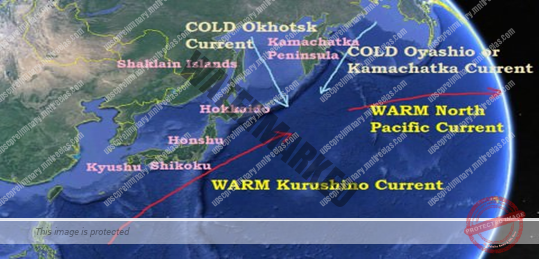- THE ASIATIC REGION
- NATURAL VEGETATION – LAURENTAIN CLIMATE
- ECONOMIC DEVELOPMENT – LAURENTAIN CLIMATE
UNIT 4 – CLIMATOLOGY – PART 47
THE ASIATIC REGION
- Rainfall distribution of the Asiatic region is far less uniformwhen compared to North American Region.
- Winters are cold and very drywhile summers are very warm and exceptionally wet.
- The rainfall regime resembles the tropical monsoon typein India.
- Intense heating of the mountainous interior of China in summer creates a region of extreme low pressure, and moisture-laden winds from the Pacific Ocean and the Sea of Japan blow in as the South-East Monsoon.
- Thus, the Laurentian type of climate in China is often described as the Cool Temperate Monsoon Climate.
- It has a very long, cold winter, and a large annual range of temperature.
- Much of the winter precipitation in northern China, Korea and Hokkaido, Japan, is in the form of
JAPAN
- The climate of Japan is modified by the meeting of warm and cold ocean currents.
- It receives adequate rainfall from both the South-East Monsoon in summer and the North- West Monsoon in winter (western coasts of Japan)
- The warm Kuroshiomakes the climate of Japan less extreme.
- The meeting zone between warm Kuroshiofrom south and cold Oyashio from the north produce fog and mist, making north Japan a ‘second Newfoundland’.
- Fishing replaces agriculture as the main occupation in many of the indented coastlands.
NATURAL VEGETATION – LAURENTIAN CLIMATE
- The predominant vegetation is cool temperate forest.
- The heavy rainfall, the warm summers, and the damp air from fogs, all favor the growth of trees.
- Forest tends to be coniferous north of the 50°N latitude.
- In the Asiatic region (eastern Siberia and Korea), the coniferous forests are a continuation of the great coniferous belt of the taiga.
LUMBERING
- Timber and fish are the leading export items.
- Much of the coniferous forests of fir, spruce and larch are exploited to a great extent.
- Eastern Canada is the heart of the Canadian timber and wood pulp industry [St. Lawrence River helps in export].
- South of latitude 50°N., the coniferous forests give way to deciduous forests. Oak, beech, maple and birch are most common.
- Almost homogeneous species of trees [pure stands], and the predominance of only a handful of species greatly enhance the commercial value of these forests.
- They have been extensively felled for the extraction of temperate hardwood. [From Laurentian Climate regions, both temperate hardwood and temperate softwood are obtained]
- In Manchuria, Korea and Japan, the forests have made way for the agriculture.
ECONOMIC DEVELOPMENT – LAURENTIAN CLIMATE
- Lumbering and its associated timber, paper and pulp industries are the most important economic undertaking.
- Agriculture is less important because of long and severe winters.
- In the North American region, farmers are engaged in dairy farming.
- The Annapolis valley in Nova Scotia is the world’s most renowned region for apples.
- Fishing is, however, the most outstanding economic activity.

[pvc_stats postid="" increase="0" show_views_today="1"]
